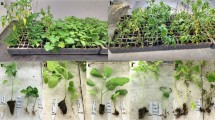Abstract
The pathogenicity of four isolates ofFusarium oxysporum obtained from infected cultivated rocket (Eruca vesicaria) and wild (sand) rocket (Diplotaxis tenuifolia) was tested on the following cruciferous hosts: stock, radish, wild and cultivated rockets, and various species in the cabbage tribe: cabbage (Brassica oleracea var.sabauda), cauliflower (Brassica oleracea var.botrytis), Brussels sprouts (Brassica oleracea var.gemmifera), broccoli (Brassica oleracea var.italica), turnip (Brassica rapa var.rapa). The results indicated that isolates ofF. oxysporum from cultivated and wild rocket belong to theforma specialis raphani. The isolates from rocket were pathogenic on cabbage, Brussels sprouts, broccoli, turnip, radish and stock; isolates ofF. oxysporum conglutinans from cabbage and radish, and the isolate ofF. oxysporum f.sp.raphani from rape obtained from the ATCC collection, were pathogenic on both cultivated and wild rocket.
Similar content being viewed by others
References
Armstrong, G.M. and Armstrong, J.K. (1952) Physiological races of the Fusaria causing wilts of the Cruciferae.Phytopathology 42:255–257.
Armstrong, G.M. and Armstrong, J.K. (1981)Formae speciales and races ofFusarium oxysporum causing wilt diseases.in: Nelson, P.E., Tousson, T.A. and Cook, R.J. [Eds.] Fusarium: Diseases, Biology, and Taxonomy. The Pennsylvania State University Press, University Park, PA, USA. pp. 391–399.
Blank, L.M. (1934) Uniformity in pathogenicity and cultural behaviour among strains of the cabbage-yellows organism.J. Agric. Res. 48:401–409.
Bosland, P.W. and Williams, P.H. (1987) An evaluation ofFusarium oxysporum from crucifers based on pathogenicity, isozyme polymorphism, vegetative compatibility, and geographic origin.Can. J. Bot. 65:2067–2073.
Bosland, P.W., Williams, P.H. and Morrison, R.H. (1988) Influence of soil temperature on the expression of yellows and wilt of crucifers byFusarium oxysporum.Plant Dis. 72:777–780.
Chatterjee, C. and Rai, J.N. (1974) Fusarium wilt ofEruca sativa — Observation on comparative pathogenicity of some strains ofFusarium oxysporum.Indian Phytopathol. 28:309–311.
Garibaldi, A., Gilardi, G. and Gullino, M.L. (2002) First report ofFusarium oxysporum onEruca vesicaria andDiplotaxis sp. in Europe.Plant Dis. 87:201.
Garibaldi, A., Gilardi, G. and Gullino, M.L. (2002) Una tracheofusariosi suEruca sativa eDiplotaxis sp. osservata per la prima volta in Europa.Inf. Fitopatol. — Dif. Piante 52(12):57–59.
Garibaldi, A., Gilardi, G., Pasquali, M., Keiji, S. and Gullino, M.L. (2005) Seed transmission ofFusarium oxysporum onEruca vesicaria andDiplotaxis muralis.Z. Pflanz. PflanzenSchutz 111:345–350.
Kendrick, J.B. (1930) Kale yellows in California caused byFusarium conglutinans Wollenw.Hilgardia 5:1–15.
Pound, G.S. and Fowler, L.F. (1951) A Fusarium wilt of radish in Wisconsin.Phytopathology 41:30.
Author information
Authors and Affiliations
Corresponding author
Additional information
http://www.phytoparasitica.org posting Feb. 14, 2006.
Rights and permissions
About this article
Cite this article
Garibaldi, A., Gilardi, G. & Gullino, M.L. Evidence for an expanded host range ofFusarium oxysporum f.sp.raphani . Phytoparasitica 34, 115–121 (2006). https://doi.org/10.1007/BF02981311
Received:
Accepted:
Issue Date:
DOI: https://doi.org/10.1007/BF02981311



